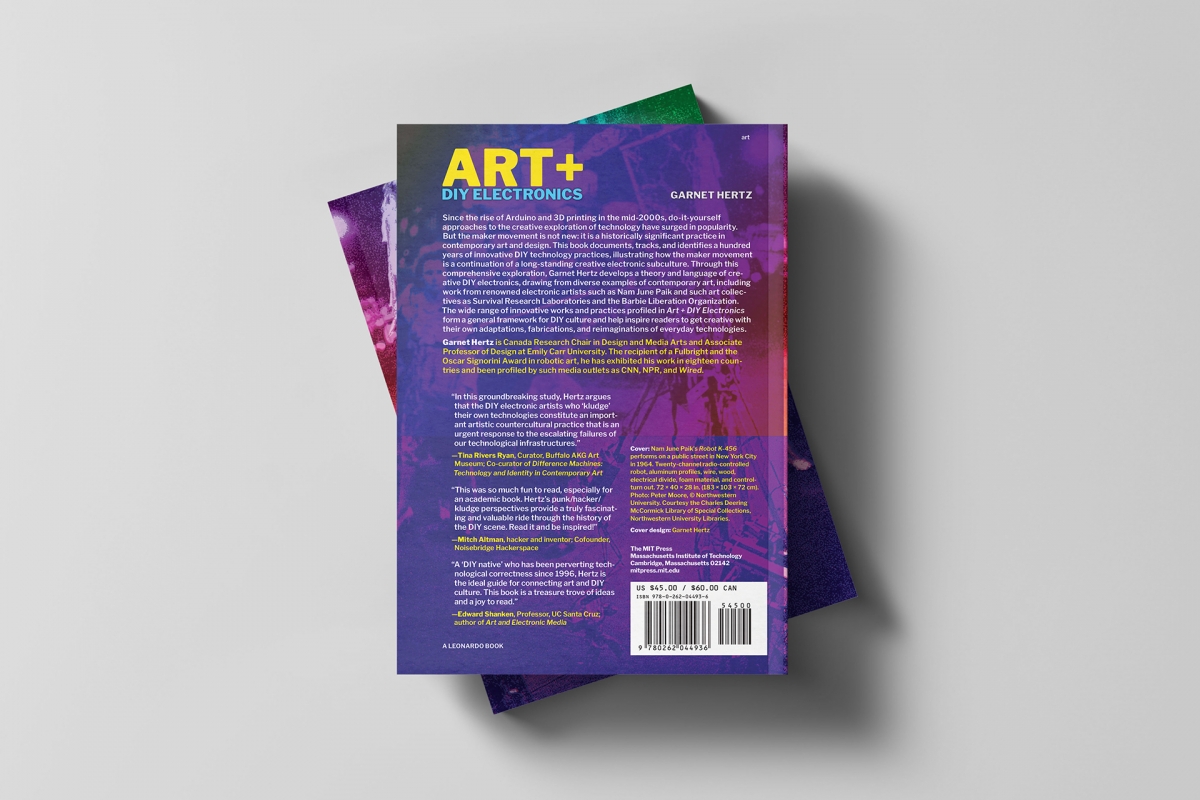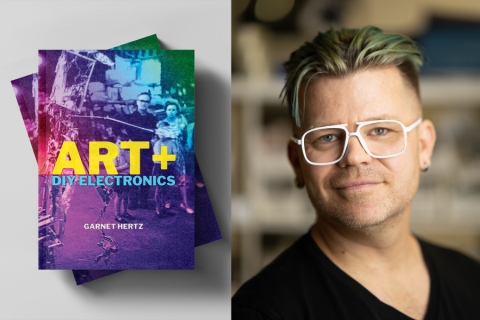Art + Technology = Innovation
Alum Garnet Hertz’s new book chronicles 100 years of innovative DIY technology practices
By Greg Hardesty
As a child and teenager, Garnet Hertz lived in two worlds.
He grew up in Saskatoon, a city in the Canadian province of Saskatchewan.
In Saskatoon, snow is on the ground a third of the year.
In the winters, Hertz stayed in Saskatoon with his father, a professor of mechanical engineering, spending hours in the lab where his dad, a stock and drag racing buff, researched fuel efficiency for passenger cars at the University of Saskatchewan.
In the summers, Hertz whiled away time on the family farm “in relatively the middle of nowhere – north of Fargo, put it that way.”
One of four boys, his hobbies included “building forts and go-karts, many forms of art and exploring the world, and lighting things on fire.”
Small wonder, then, that the tinkerer with an artistic streak – Hertz’s mother and grandmother were painters – became an academic specializing in art and design, with a focus on DIY (do it yourself) culture, electronic art and critical design practices.
New Book
The UCI alum (Ph.D. ’09 Visual Studies, School of Humanities; M.F.A. ’05 Arts Computation Engineering, Claire Trevor School of the Arts, Computer Science, and Engineering) this spring is dropping his first book from a major academic publisher, Art + DIY Electronics (MIT Press, May 30, 2023).
The book chronicles 100 years of innovative DIY technology practices, illustrating how the Maker Movement – a catch-all term for inventors and designers who include computer nerds and traditional artists – is a continuation of a longstanding creative electronic subculture.
“It primarily looks at unique and productive ways artists have repurposed and used technology in innovative and unexpected ways,” says Hertz, an associate professor of design and Canada Research Chair in Design and Media Arts at Emily Carr University of Art and Design in Vancouver, B.C.
Art + DIY Electronics primarily looks at unique and productive ways artists have repurposed and used technology in innovative and unexpected ways.
Hertz says his book has many themes related to creativity and technology, including how to be innovative with a lack of resources, exploring personal identity through technology, and protest/anti-establishment movements.
An example of the latter in Art + DIY Electronics is the Barbie Liberalization Organization (BLO), which gained notoriety in 1993 when the group of maverick artists and activists switched voice boxes in talking G.I. Joe and Barbie dolls to underscore gender stereotyping by toy manufacturing.
After the subversive switch when the dolls had been returned to shelves, unwitting purchasers would discover their Teen Talk Barbie saying such things as “Vengeance is mine!” while G.I. Joe dolls would utter such phrases as “The beach is the place for summer!”
Says Hertz: “This happened at a time when viral corporate pranking was not really being done.”
He adds with a touch of pride: “I’ve been involved in things like this, and I know those (BLO) people.”

Image: The back of Hertz's new book, Art + DIY Electronics.
The Hissing Cockroach
The Maker Movement surged in popularity with the advent of 3-D printing in the mid-2000s, and Hertz was involved from the start.
In the mid-2000s, while working on his M.F.A. at UCI, he made international news for a device he made that fused a living insect and electronic machinery.
Hertz’s Cockroach Controlled Mobile Robot featured a Giant Madagascar hissing cockroach, two freakish inches in length, that was strapped in a harness atop a modified computer track ball.
The roach’s movements propelled a three-wheeled robot around the floor, an early example of a hybrid biological/machine system, with the roach serving as a kind of living central processing unit.
More recently (2021), for an art installation, Hertz created Phone Safe, a locked box with a slot in the top to put your mobile phone. Pressing a button adds time that your phone will be locked inside, and the phone is not retrievable while in the locked box and there is no way to reduce your time.
Perhaps not surprisingly, the inspiration for Phone Safe was Hertz’s four children, who today range in age from 11 to 25.
Plan B
Going to graduate school was Plan B for Hertz.
He earned his undergraduate degree in studio art and art history from the University of Saskatchewan in 1997. At his B.F.A. show, he introduced an Internet-controlled drawing machine. While logged onto a website, people could manipulate a robot that would scratch lines into the ground.
“That was the first mechanical thing I made that was popular,” Hertz says. “I was like, ‘Oh, wow – people like this. This is, like, a thing.”
Hertz then launched a commercial design firm. But the startup tried to go to an initial public offering but failed during the dot.com swoon in the early 2000s.
Hertz then won a Fulbright award for graduate school and he picked UCI for its then-new (and since discontinued) M.F.A. in Arts Computation Engineering.
“It was dynamic and interesting,” he says of the graduate program.
Hertz credits UCI for helping him gain exposure with his cockroach contraption, which landed him on the front page of The New York Times, exhibitions across the globe, and on NBC with Keith Olbermann.
Also, while at UCI, Hertz organized a Meetup group called Dork Bot, which he says helped give birth to the contemporary Maker Movement.
After earning his Ph.D., Hertz remained at UCI, first as a postdoctoral scholar in the Institute for Software Research and, for about five years, as a research scientist in the Department of Informatics.
He accepted his professorship in Vancouver in 2014.
At Emily Carr, a public post-secondary university dedicated to art and design, Hertz runs a lab called The Studio for Critical Making.
Oh, the Humanity
Hertz’s three brothers also inherited his tech geek gene. One has a Ph.D. in robotics, another is an electrical engineer, and the third is a mechanical engineer.
“I was the most creative one,” Hertz says, “so I ended up doing art.”
Hertz’s works have been exhibited in 18 countries and he has won top international awards, including the Oscar Signorini Prize in robotic art.
In several of his works, Hertz repurposes obsolete media technologies. His 2009 work OutRun turned an arcade video game cabinet into a vehicle. As the vehicle is driven, it converts the camera view of the real street into an 8-bit video screen view that the driver uses to navigate.
One of Hertz’s core beliefs is that the arts and humanities can be useful tools in addressing the information overload afflicting modern society.
Sure, he says, technology is great and allows people to connect with each other in new ways. But new technology also means people are constantly being disrupted.
Part of the blame, he says, is the result of technology designers’ desire to maximize users’ productivity without giving enough thought to how these modern tools affect individuals and society at large. Technology, Hertz says, needs to be more human-focused.
“If technology is to improve society,” Hertz says, “it must be designed for the complexities of what it means to be human. And being human is far from simple.”
Learn more about Garnet Hertz and his new book on his website, www.conceptlab.com.
Please visit our secure direct giving page and make a gift to support Art today!

